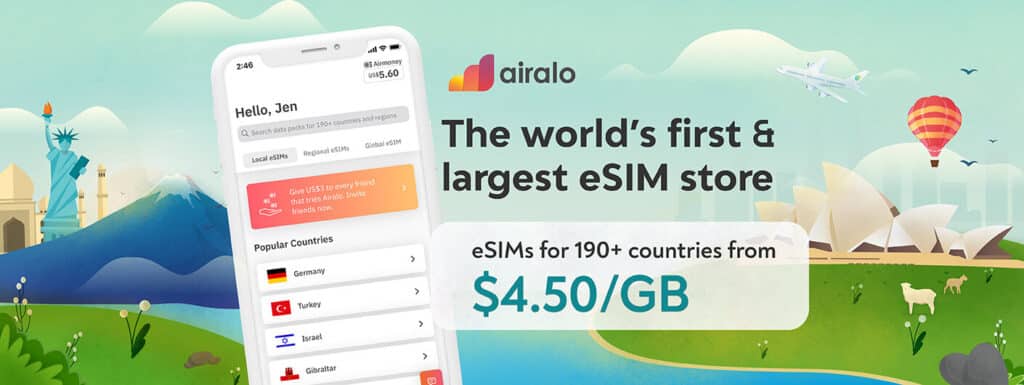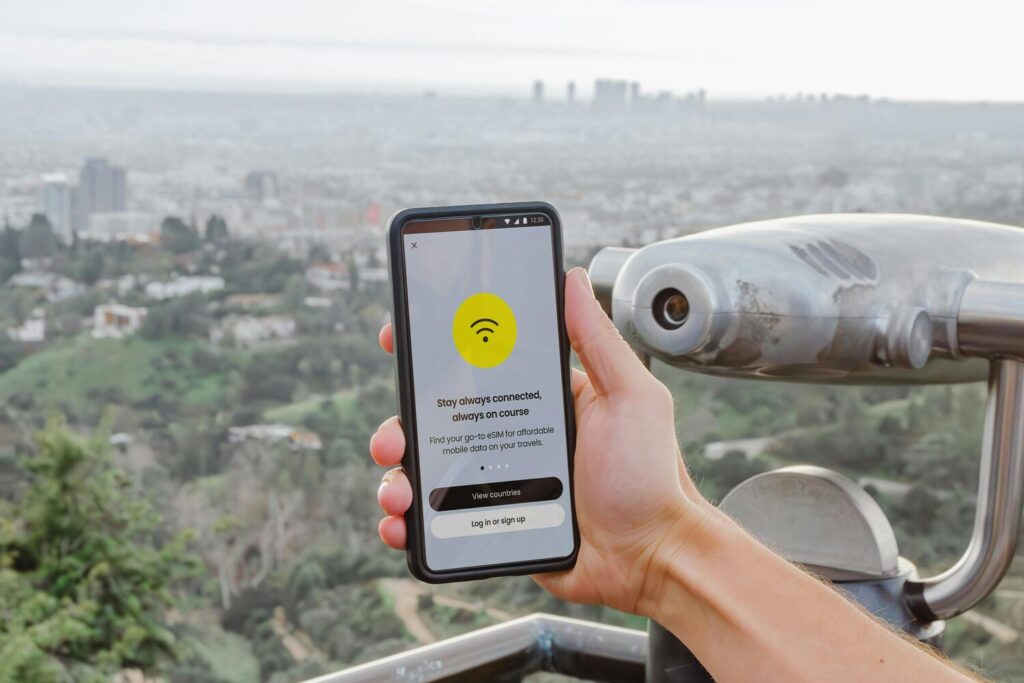
Apple eSim Review
When it comes to staying connected whilst you are on the go, Apple’s eSIM technology remains one of the best options for travelers in 2025.
Built right into most iPhones, iPads, and even some Macs, Apple eSIM gives digital nomads, business travelers, and foreign tourists a simple way to connect to mobile networks without swapping physical SIM cards.
Regardless of whether you’re a budget traveler hopping countries or a remote worker needing reliable high-speed internet across continents, Apple’s eSIM ecosystem has you covered.
Some of the things that make it stand out are its wide global coverage, highly competitive pricing through a range of partner networks, flexible plans, and the ability to activate unlimited data options. Best of all, you can access them anytime, anywhere, without having to visit a mobile store.
In this review, we’ll explore everything you need to know before you rely on Apple eSIM for your next trip. We’ll cover pricing structures, coverage quality, internet speed performance, ease of use, setup experience, and even give you a quick rundown of its biggest pros and cons.
If you’re looking for a seamless, stress-free mobile connection while traveling, Apple’s eSIM could be exactly what you need. Let’s take a closer look at why.
Overview of Apple eSIM
Apple was founded by Steve Jobs, Steve Wozniak, and Ronald Wayne back in 1976, and is now one of the most trusted and recognized technology brands in the world today.
With decades of innovation under its belt and countless awards for design, engineering, and customer satisfaction, it’s no surprise that Apple has become a leader in eSIM technology, too.
While Apple doesn’t operate a standalone eSIM service (like Airalo or Holafly), it has built an incredibly smooth eSIM platform into its devices, partnering with major carriers globally.
Its main competition comes from specialized eSIM marketplaces, but Apple’s advantage is clear. Namely, built-in convenience, instant activation, and the ability to choose from a wide range of international carriers.
Key Features at a Glance:
Overall, Apple’s eSim is ideal for those who want an option that provides them with flexibility and speed. Here is a quick overview of some of its key features.
- The eSIM can be used in over 190 countries worldwide through carrier partnerships.
- In terms of network support, 4G LTE is widespread, while 5G access is rapidly growing in major cities worldwide.
- Its prices are generally competitive, with plenty of options available for budget travelers and premium users.
- The eSIM is controlled through existing iOS Settings, so it does not require you to download other apps.
- Most plans will activate instantly after purchase, which takes less than five minutes to set up.
Coverage & Network Reliability
One of the biggest strengths of Apple’s eSIM platform is its truly global reach.
Thanks to partnerships with leading carriers like AT&T, Vodafone, Orange, T-Mobile, and many others, Apple eSIM users can access mobile data in over 190 countries worldwide – from Afghanistan to Zimbabwe.
As it is one of the most extensive options available on the market today, you will have the peace of mind of knowing that if you’re island-hopping across Micronesia or working remotely in Africa, you’re rarely out of reach.
Here’s an overview of the coverage you can expect:
Europe: Users traveling through Europe, particularly countries like Germany, France, and Spain, will enjoy excellent performance, thanks to partnerships with Vodafone and Orange.
North America: In urban areas across the United States and Canada, Apple eSIM taps into networks like AT&T and T-Mobile to provide seamless 5G speeds for users. However, in rural regions, particularly parts of Canada and the Midwest USA, you might experience slower 4G connections.
Asia: Apple eSIM coverage is solid in tech-heavy countries like Japan and South Korea. However, in parts of India and China, coverage can be a little patchy, given their size and the remoteness of some locations in them.
South America & Africa: While major cities in countries like Brazil and South Africa offer decent 4G coverage, other parts of this region can suffer from weaker signals and slower speeds.
Data Plans & Pricing
Apple’s eSIM doesn’t offer direct plans itself. Instead, it connects users to a marketplace of carrier options, which gives travelers the flexibility to pick plans that suit their needs.
You’ll find a mix of pay-as-you-go options, unlimited data plans, regional packages, and global bundles, all accessible directly from your device.
Pricing Breakdown:
- Some of the cheapest plans can start as low as $5 for 1GB of data valid for 7 days in popular destinations like the US or UK.
- Premium global plans offering unlimited data for multiple countries can reach $80–$100 for 30 days.
- Long-term travelers may occasionally find discounted packages for 60+ day bundles, depending on the carrier.
Compared to what is offered by the likes of Airalo, Holafly, and Nomad, Apple’s marketplace prices are generally mid-range. While they are not the absolute cheapest, they do offer excellent value due to the speed at which you can activate them, their better network partnerships, and the fact that they generally experience fewer technical issues.
Generally, there are no hidden fees. So, what you see is what you pay. However, you should always double-check if your chosen plan includes hotspot/tethering, as some providers may limit it or require a small surcharge.
Most plans last 7, 15, or 30 days after activation, so make sure you check with the expiration timeframe clearly outlined before making a purchase.
Internet Speed & Network Performance
Typically, Apple eSIM users generally enjoy excellent internet speeds across most major regions.
Speed tests report consistent 4G LTE performance with true 5G access now available in major cities across Europe, North America, and parts of Asia. Average speeds usually range from 100–300 Mbps on 5G networks and 30–100 Mbps on 4G, which is more than enough for HD streaming, gaming, large file downloads, and smooth video calls.
At the same time, latency is impressively low, which makes it ideal for business travelers who rely on real-time communication tools like Zoom or Slack. Most carriers also allow full-speed hotspot/tethering, though a few users note slight throttling once high data limits (like 50 GB+) are exceeded.
In general, real-world feedback about Apple eSim is largely positive. Those who have reviewed it on Google, Facebook and sites like TrustPilot tend to highlight stable speeds even during peak hours in busy cities like London, New York, and Tokyo.
However, as previously touched upon, remote rural areas and overcrowded tourist hubs can experience occasional slowdowns during holiday seasons.
Ease of Use & Setup Process
Apple nails the user experience when it comes to eSIM activation because it does not require messy downloads or confusing steps.
To set it up, you should open Settings and then navigate to Cellular and Add eSIM. Once there, choose a carrier from the marketplace or scan a QR code provided by a carrier website. After that, just follow the simple prompts until activation is complete, which usually is within minutes.
Because everything happens inside the iOS Settings app, you should find managing multiple eSIMs to be a clean and organized process. You will be able to easily switch between personal and travel numbers, view remaining data balances, and disable plans with just a tap.
Customer Support:
While Apple itself doesn’t handle carrier issues, most partner networks offer 24/7 support through live chat, email, or phone. It is worth noting that response times will vary, but as a general rule, most queries are usually resolved within a few hours.
For device-related issues, Apple’s own support is famously fast and reliable around the world.
Pros & Cons of Apple eSIM
Like with most products and services, there are several pros and a few cons associated with Apple eSIM. Here is a brief rundown of what they are.
Pros:
- Global Coverage in over 190 countries worldwide.
- Instant activation within minutes directly from your device.
- Flexible pricing plans that enable you to choose between pay-as-you-go, regional, or unlimited data bundles.
- User-friendly interface that does not require extra apps because everything is managed through iOS Settings.
- Strong network partners that provide access to top carriers like AT&T, Vodafone, and Orange.
Cons:
- Some plans are pricier than third-party eSIM providers.
- In remote or rural areas, network reliability is not as good as in cities.
- The quality of customer service you receive depends on the partner network, not Apple itself.
How does Apple eSIM Compare to Other eSIM Providers?
When compared to popular providers like Airalo, Holafly, and Nomad, most tech experts agree that Apple eSIM offers a more seamless and device-integrated experience than its rivals.
One of its best features is that you don’t need to download separate apps or manage extra logins because everything happens within your iPhone’s Settings.
It’s true that the likes of Airalo and Holafly may offer slightly cheaper short-term deals, but Apple’s partner carrier plans often provide better reliability, faster speeds, and wider 5G access. Additionally, for digital nomads and business travelers who prioritise ease of setup and consistent performance, Apple’s ecosystem is tough to beat, even if it sometimes comes at a slightly higher price point.
Final Verdict: Is Apple eSIM Worth It?
Thanks to its seamless setup, strong global coverage, and reliable network performance, Apple eSIM remains one of the best options available for those who want connectivity when they are miles from home.
While it might not always provide you with the cheapest option, it’s easy to use and offers trustworthy carrier partnerships. This makes it a top choice, in particular, for digital nomads and remote workers.








Responses